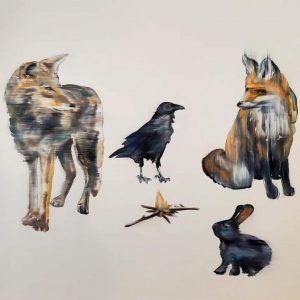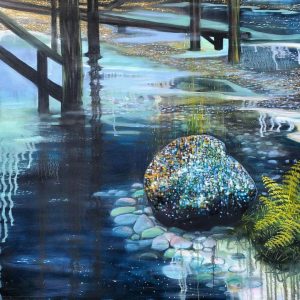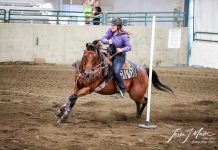Skagit artist Todd Horton has painted full time since 2008. His art is distinctive with emotions and movement. There’s frequently a wispy, blurry motion within. There’s also simplicity about them and sometimes brilliant colors as a backdrop or a focal point. Horton, a resident of Edison along the water, initially painted mainly foxes, but also has brought to life bears, crows, and other wildlife. Each painting bearing his trademark movement.
Movement and Foxes

Why create movement in a still picture? Horton said he had made a mistake while painting and started scraping the oil paint away with his palette knife to try to fix it. In the process, he saw a beautiful thing emerging as the paint had left trails. He decided to leave them there and to embrace it. He now paints lose and thick and drags a large dry brush through it to achieve that instead of utilizing the palette knife. “I don’t mix paint on a palette,” he says. He takes the paint directly from the tube, working primarily with six or seven colors, and proceeds to mix while painting on the canvas.
Many of his paintings includes foxes, for a tragic reason. Horton was driving in Vermont around 20 years ago and his path crossed with a fox. “I hit a fox,” he shares. “I saw a blur and then it was lying in the headlights. Our eyes met and held.” It was a mystical connection between him and the dying creature. After the fox died, Horton has not forgotten it and continues to paint it as a memorial.
It was another drive that brought him to the West Coast and to Bellingham, specifically, in about 1998. That visit made him fall in love with the Pacific Northwest. He grew up in Ohio, and in contrast to Washington it is flat and not near water, Horton shares.

After working abroad in big cities in Germany, Korea and Japan, Horton was ready for something different. Something smaller. His neighbors now are a mixture of a handful of people and wildlife he loves. Outside of his studio he sees blackbirds with their young learning to fly, salmon and fishermen, seals, otters, blue heron, and mink. These animals make their way into his heart and his paintings. “This is the place that inspires me,” Horton shares. Since his move, other family also relocated here from Ohio.
Todd Horton Sees Animals in Art and Culture
Horton sees the animals in both literal and figurative ways. Different animals within the framework of culture and language are significant. “The word bear is linked with bearing arms, bearing a child, or bearing arms.” All convey strength, he says. He has looked, from curiosity and for guidance, to the myths in different cultures as well as to learn from the natural world.
The Day in The Life of a Painter

A typical day for him as a working artist includes doing administrative tasks over coffee or tea first thing, tidying up his small space, and getting to his boat studio on the Samish River between 9 a.m. and 10 a.m. to work for a few hours before breaking for lunch and errands. He walks along the nearby dike and returns around 4 p.m. to paint for a few more hours. He glances from the many windows to enjoy the vivid sunsets.
Horton’s work is seen in prominent galleries from local Smith & Vallee Gallery in Edison to Seattle Art Museum and Bozeman’s Visions West Gallery as well as on walls of friends.
During COVID, he started offering up via Facebook small simpler paintings he could often do in an hour for $80. Once he would post the work would often be claimed within minutes since some fans or collectors caught on to his routine of when he would post. When they came to pick up the art, sometimes they would end up buying larger paintings, bring him homemade cookies, and even became new friends.
Todd Horton’s work can also be viewed on the Todd Horton website.




































